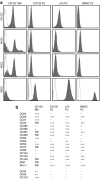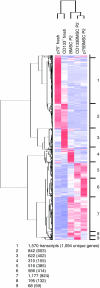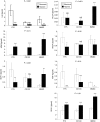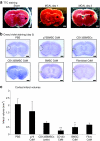CD133 identifies a human bone marrow stem/progenitor cell sub-population with a repertoire of secreted factors that protect against stroke
- PMID: 19690521
- PMCID: PMC2835040
- DOI: 10.1038/mt.2009.185
CD133 identifies a human bone marrow stem/progenitor cell sub-population with a repertoire of secreted factors that protect against stroke
Abstract
The reparative properties of bone marrow stromal cells (BMSCs) have been attributed in part to the paracrine action of secreted factors. We isolated typical human BMSCs by plastic adherence and compared them with BMSC sub-populations isolated by magnetic-activated cell sorting against CD133 (CD133-derived BMSCs, CD133BMSCs) or CD271 [p75 low-affinity nerve growth factor receptor (p75LNGFR), p75BMSCs]. Microarray assays of expressed genes, and enzyme-linked immunosorbent assays (ELISAs) of selected growth factors and cytokines secreted under normoxic and hypoxic conditions demonstrated that the three transit-amplifying progenitor cell populations were distinct from one another. CD133BMSC-conditioned medium (CdM) was superior to p75BMSC CdM in protecting neural progenitor cells against cell death during growth factor/nutrient withdrawal. Intracardiac (arterial) administration of concentrated CD133BMSC CdM provided neuroprotection and significantly reduced cortical infarct volumes in mice following cerebral ischemia. In support of the paracrine hypothesis for BMSC action, intra-arterial infusion of CD133BMSC CdM provided significantly greater protection against stroke compared with the effects of CD133BMSC (cell) administration. CdM from CD133BMSCs also provided superior protection against stroke compared with that conferred by CdM from p75BMSCs or typically isolated BMSCs. CD133 identifies a sub-population of nonhematopoietic stem/progenitor cells from adult human bone marrow, and CD133BMSC CdM may provide neuroprotection for patients with stroke.
Figures







References
-
- Till JE., and , McCulloch EA. A direct measurement of the radiation sensitivity of normal mouse bone marrow cells. Radiat Res. 1961;14:213–222. - PubMed
-
- Morrison SJ, Uchida N., and , Weissman IL. The biology of hematopoietic stem cells. Annu Rev Cell Dev Biol. 1995;11:35–71. - PubMed
-
- Akashi K, Traver D, Miyamoto T., and , Weissman IL. A clonogenic common myeloid progenitor that gives rise to all myeloid lineages. Nature. 2000;404:193–197. - PubMed
-
- Kondo M, Weissman IL., and , Akashi K. Identification of clonogenic common lymphoid progenitors in mouse bone marrow. Cell. 1997;91:661–672. - PubMed
Publication types
MeSH terms
Substances
Grants and funding
LinkOut - more resources
Full Text Sources
Other Literature Sources
Medical
Research Materials
Miscellaneous

